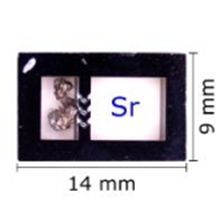Summary
We focus on developing methods for performing precision optical spectroscopy in compact, manufacturable devices based on warm atomic vapors. Projects range from integration of nanophotonic chips with vapor cells for applications in dimensional metrology to development of high temperature vapor cells for investigating spectroscopy of alkaline earth species.
Description

The NIST on a Chip project in the Atomic Devices and Instrumentation group is focused on the development of compact, manufacturable, low power, SI-traceable calibration instruments using atomic vapor cells. We anticipate such devices could be broadly used in industrial settings for in-situ calibration of instruments and systems. This technology is inspired by past work on chip-scale atomic clocks, which were invented at NIST and have been successfully commercialized.
A presentation summarizing the NIST on a Chip program made to the NIST Visiting Committee on Advanced Technology can be found here.
Publications
[1] Matthew T. Hummon, Songbai Kang, Douglas G. Bopp, Qing Li, Daron A. Westly, Sangsik Kim, Connor Fredrick, Scott A. Diddams, Kartik Srinivasan, Vladimir Aksyuk, and John E. Kitching, "Photonic chip for laser stabilization to an atomic vapor with 10−11 instability," Optica 5, 443-449 (2018)
Rubidium two-photon optical clock
The rubidium two-photon optical clock project is developing low size, weight, and power optical frequency references based on miniature optical components. These devices have the potential to surpass the performance of hydrogen maser clocks, at a fraction of the overall size and power requirements, enabling new applications for high performance atomic timing.


Publications
[2] Zachary L. Newman, Vincent Maurice, Tara Drake, Jordan R. Stone, Travis C. Briles, Daryl T. Spencer, Connor Fredrick, Qing Li, Daron Westly, B. R. Ilic, Boqiang Shen, Myoung-Gyun Suh, Ki Youl Yang, Cort Johnson, David M. S. Johnson, Leo Hollberg, Kerry J. Vahala, Kartik Srinivasan, Scott A. Diddams, John Kitching, Scott B. Papp, and Matthew T. Hummon, "Architecture for the photonic integration of an optical atomic clock," Optica 6, 680-685 (2019)
[3] Vincent Maurice, Zachary L. Newman, Susannah Dickerson, Morgan Rivers, James Hsiao, Phillip Greene, Mark Mescher, John Kitching, Matthew T. Hummon, and Cort Johnson, "Miniaturized optical frequency reference for next-generation portable optical clocks," Opt. Express 28, 24708-24720 (2020)
[4] Zachary L. Newman, Vincent Maurice, Connor Fredrick, Tara Fortier, Holly Leopardi, Leo Hollberg, Scott A. Diddams, John Kitching, and Matthew T. Hummon, "High-performance, compact optical standard," Opt. Lett. 46, 4702-4705 (2021)
Microfabricated Strontium Vapor Cells

Alkaline earth atoms have optical transitions with extremely narrow linewidths, making them well suited for optical atomic clock applications. The narrowest transitions require complex experiments with ultracold atoms trapped in optical lattices for interrogation. However, strontium has a transition that can still be probed in a warm atomic vapor, while still offering linewidths 10 to 100 times narrower than transitions in alkali atoms. We have developed high temperature microfabricated vapor cells for investigation of precision spectroscopy in strontium and other alkaline earth species.
Publications
[5] Jacob M. Pate, John Kitching, and Matthew T. Hummon, "Microfabricated strontium atomic vapor cells," Opt. Lett. 48, 383-386 (2023)

